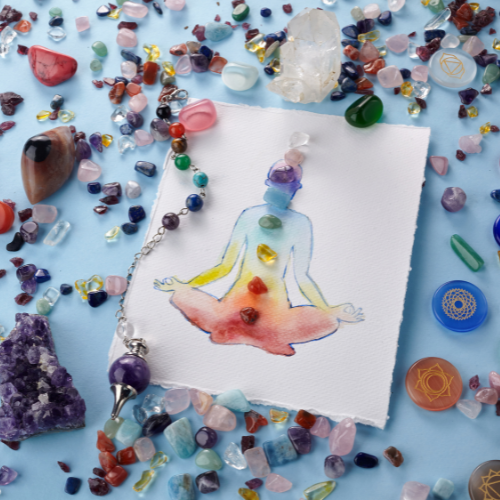Chakras are an ancient system of energy centers within the human body. These centers play a crucial role in our physical, emotional, and spiritual well-being. While the concept of chakras originates from Eastern traditions like Hinduism and Buddhism, it has gained popularity worldwide as a holistic approach to achieving balance and harmony in life. If you're new to the world of chakras, this beginner's guide will provide you with a foundational understanding of what chakras are and how you can begin working with them to enhance your overall well-being.
What Are Chakras?
The word "chakra" comes from the Sanskrit language, meaning "wheel" or "disk." Chakras are often described as spinning wheels or vortexes of energy located along the central axis of the body, from the base of the spine to the crown of the head. There are seven primary chakras, each associated with specific areas of the body and aspects of our lives:
-
Root Chakra (Muladhara) - Located at the base of the spine, the root chakra represents our sense of security, stability, and connection to the physical world.
-
Sacral Chakra (Svadhisthana) - Positioned in the lower abdomen, the sacral chakra is linked to creativity, sensuality, and emotional expression.
-
Solar Plexus Chakra (Manipura) - Situated in the upper abdomen, this chakra governs our self-esteem, personal power, and confidence.
-
Heart Chakra (Anahata) - Located in the chest area, the heart chakra relates to love, compassion, and emotional healing.
-
Throat Chakra (Vishuddha) - Found in the throat, this chakra is associated with communication, self-expression, and authenticity.
-
Third Eye Chakra (Ajna) - Positioned between the eyebrows, the third eye chakra represents intuition, insight, and inner wisdom.
-
Crown Chakra (Sahasrara) - Situated at the top of the head, the crown chakra connects us to higher states of consciousness and spirituality.
Balancing and Aligning Chakras
Balancing and aligning your chakras is the process of ensuring that the energy flowing through these centers is neither excessive nor deficient. When your chakras are balanced, you may experience improved physical health, emotional stability, mental clarity, and a heightened sense of spiritual connection.
Here are some practical steps to begin balancing and aligning your chakras:
-
Meditation: Meditation is one of the most effective ways to connect with your chakras. Focus on each chakra, visualize its associated color (e.g., red for the root chakra, green for the heart chakra), and imagine it spinning smoothly and freely. This helps clear any blockages or excess energy.
-
Chakra Yoga: Yoga poses and sequences designed to target specific chakras can help release tension and promote balance. Consider incorporating yoga into your daily routine.
-
Breathing Exercises: Controlled breathing exercises, such as pranayama in yoga, can stimulate and balance chakras. Deep, mindful breathing helps regulate energy flow.
-
Crystal Healing: Crystals and gemstones are believed to have unique energetic properties that can influence chakras. Experiment with crystals that resonate with each chakra, like amethyst for the crown or rose quartz for the heart.
-
Aromatherapy: Essential oils can be used to stimulate and balance chakras. Choose scents that correspond to the chakra you want to work on. For example, lavender for the crown chakra or orange for the sacral chakra.
-
Sound Healing: Certain sounds and vibrations are associated with each chakra. Chanting mantras or using singing bowls tuned to specific frequencies can help balance and align these energy centers.
-
Chakra Affirmations: Positive affirmations can reprogram your mind and support chakra healing. Create affirmations that resonate with each chakra's qualities and repeat them daily.
-
Healthy Lifestyle: Maintaining a balanced lifestyle through proper nutrition, regular exercise, and adequate rest can positively impact your chakras.
Understanding and working with chakras can be a transformative journey towards holistic well-being. While this beginner's guide provides a foundational understanding of chakras and their significance, it's important to remember that chakra work is a personal and ongoing practice. Be patient with yourself, and allow the process to unfold at your own pace. As you explore and balance your chakras, you may find that you experience greater harmony in all aspects of your life, from your physical health to your emotional and spiritual well-being.
